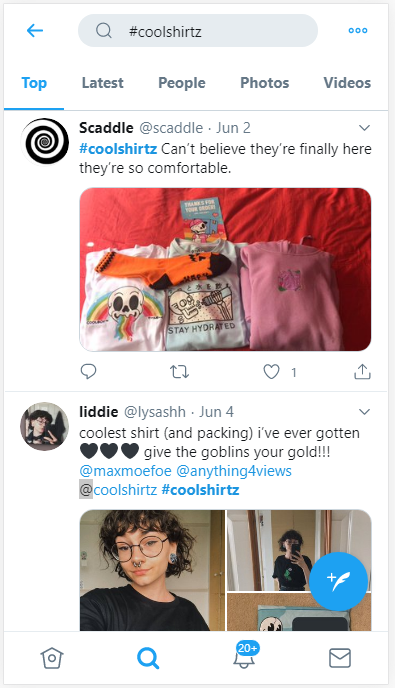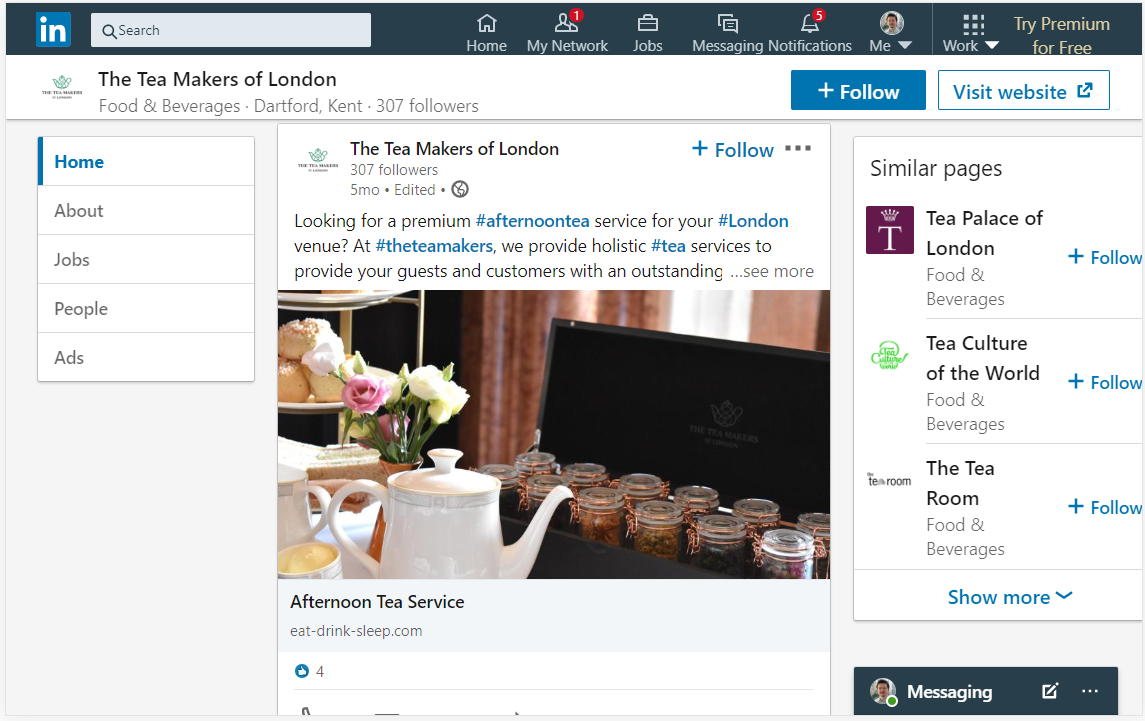SEO Tips for E-commerce: Improve Your Online Shop's Ranking in Google
SEO is an important tool for e-commerce businesses to bring in new customers. Here are the best tips for your online shop to rank higher in Google.

Using social media to promote your online shop is no new strategy. If you want your online shop to grow not only its reach but its customers, you probably already have social media integrated in your marketing strategy. However, there are certain things that you should take a closer look at. One of them is the use of hashtags in your posts.
In this article, we’ll show you how you can improve your social media marketing with hashtags!
Contents:
A hashtag is a word (or a string of words) preceded by a hash or pound sign (#). They are used to "tag" posts on social networks such as Twitter, Facebook, Instagram etc. and are often used to get posts discovered by other users.
As hashtags are clickable (and searchable), clicking such a hashtag would then lead you to a hashtag overview page for that specific term. Here, you’ll find all the posts that users created using this particular hashtag in chronological order (or other sorting options). Many users use this function to discover new content related to their interests, location, etc.

Local businesses might tag their posts with #londontown to get some more foot traffic
(Source: Instagram)
In most social media networks, you can see which hashtags are currently being used most by users (“trending”). Therefore, you can identify which content and what topics are enormously popular and are increasingly being discussed in the respective country, region or group.
The most popular social media platforms that use hashtags are Twitter (the originators), Instagram, and Pinterest. However, even LinkedIn and Facebook use them to a lesser degree as well.
With appropriate hashtags, you’re more likely to reach potential new customers for your online shop. Remember, gathering an organic social media following tends to be a long-term strategy. They might not become customers directly, but if the continue to engage with your content, you'll increase those odds.
People who don’t follow your social media profile yet might come across your page based on the hashtags you use and then decide to visit your profile.
In fact, including good hashtags in your social media strategy is an effective (and essential) way to get more people to follow your online shop's social media profile and consequently, it increases engagement and brand awareness.
Think of hashtags as a combination of SEO and targeting strategies.

Shutterstock/Rawpixel.com
By focussing on a set of keywords (which is what hashtags essentially are), you can get discovered when your posts show up in these hashtag overview pages. This is much like a specific keyword search leading to a page on your website.
Just as you might do research on your audience and create a buyer persona to figure out which keywords you should use on your website and online marketing campaigns, knowing what hashtags they use is an important part of effective targeting as well.
There are basically three different types of hashtags that can guide your marketing strategies:
These types of hashtags are probably the most interesting ones for you. With these, you can promote products, slogans, campaigns, or your brand in general.
With that in mind, you should make sure to work with a unique hashtag that will be associated with your company and brand.
Recommended reading:
The Big Branding Guide: Logos, Social Media and much more!
Get people on social media to use these hashtags as well (e.g. with a photo contest)! That way they end up promoting your company with their own posts!
Coolshirtz, a fashion company, includes brand and campaign hashtags in their social media accounts and encourages their customers to use their hashtags as well.

#BeCreative #BeMemorable
As you have probably already guessed, trending hashtags are based on topics that are popular on social media at the moment.
If you come across a trending hashtag that may be associated with your business or product, you should definitely include it in your posts.
Posts containing these types of hashtags can potentially get seen by the broader public.
The risk is, of course, possibly jumping on a controversial trend. This is probably the riskiest strategy for a business as it has the most potential for public backlash if your intentions seem insincere.
OnlineHomeShopUK , a company that sells home furnishings took part in the pillow dress challenge (#pillowdresschallenge).
%20(1).png)
#CheckTheTrends #ProceedWithCaution
When using content hashtags, you simply want to choose hashtags that relate to your post’s content. This is like tagging your post by category.
With these kinds of hashtags, you directly engage with your followers (or rather your target audience), so this is also very relevant for businesses.
For example, if you sell tea in your online shop, you could share images of your products adding hashtags like #tea, but you can also be creative and use hashtags like #teaparty or #timefortea.
The Tea Makers of London include content hashtags in their post on LinkedIn. The hashtags include #afternoontea #theteamakers and of course good old fashioned #tea.

#CreativeButRelevant
Here are some do’s and don’ts when it comes to hashtagging.
Before you share any hashtag on social media, you should find out what your audience is talking about.
Check what your followers post on social media. This can help you figure out what the most appropriate hashtags in this community are.
Go through your list of followers and try to find out what topics or wishes they share.
What hashtags do they use?
Maybe you can insert some of those ideas, or even their hashtags, to your campaigns or certain posts.
Even if you decide not to use the same hashtags, the research will still help you understand your followers (and potential customers) better and you might even want to modify your campaigns or posts afterwards.
This strategy especially applies for businesses that want to execute a certain business strategy or promote special products via social media.

Non-profits also use social media. Here, an animal shelter, @londonanimalcare, uses a few different hashtags (#cat, #cats, #catnipandchill, etc.)
#KnowYourAudience
Recommended reading:
How to Sell Unique Products to Niche Markets
We hinted at this a few sections back, but you can of course target very popular hashtags. However, just like with SEO, popular “keywords” mean a lot of competition.
If you’ve never heard of long tail keywords, the concept is simple. Short, single-word search terms (e.g. tea) might get millions of searches. That is a lot of viewers, but it also means that hundreds of companies are competing for a high ranking for the word “tea”.

Shutterstock/Rawpixel.com
However, a word like “tea party” might have less total searches, but the people who do search for that term are going to be more engaged and are more likely to be tea enthusiasts - your ideal customer.
In other words, by finding “less popular” hashtags, you might end up finding a small, but highly-engaged niche market. Sure, they might have less posts, but those exploring the hashtag might just be your target audience.
#TeaForTwo
After you finish doing your research, you can go ahead and create posts that include hashtags.
Try to come up with some that are both catchy and simple.
For readability, you should capitalise the first letter of every word. (#EasyToRead)
Keep in mind that your social media marketing strategy and your ‘hashtagging’ should depend on the social media platform you’re using.
In Twitter, for example, you should only use one or two hashtags per post, whereas on Instagram a good number of hashtags would be between eight and ten. With Facebook and LinkedIn, you’ll probably also want to limit it to one or two.
#GoodAdvice #DontOverdoIt #UnlessYoureOnInstagram
Don’t post any hashtag without having researched about it first.
Also, people probably won’t remember your hashtags if you don’t try to keep them as short as possible. (#ThisGetsReallyHardToReadDontYouThink)
Don’t hashtag every single word! (#No #one #wants #to #read #like #this #either)
Try your best to add the hashtags at the time of posting (not afterwards). If you add the hashtag afterwards on Instagram, your post will still appear in the hashtag page according to the original post time, not when you add the hashtag. This makes the post less discoverable.
Avoid using hashtags with a second meaning - they might get your followers and your prospective audience confused.
Including hashtags in your social media posts can lead to a growing audience, reaching potential customers on the platform and boosting your engagement.
That’s why hashtags are a great way for you to give your online shop a boost on social media!
#GoodLuck trying out your new #Hashtags!
21/06/22SEO is an important tool for e-commerce businesses to bring in new customers. Here are the best tips for your online shop to rank higher in Google.
Valentine's Day has grown in popularity across Europe. We're sharing some romantic statistics (redundant, right?) and look at 9 marketing tips for V-day.